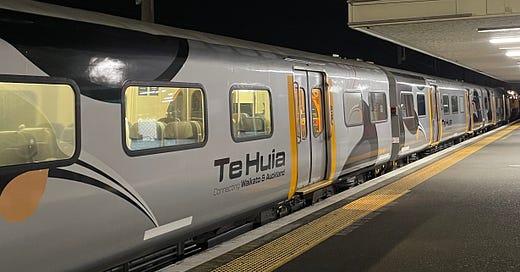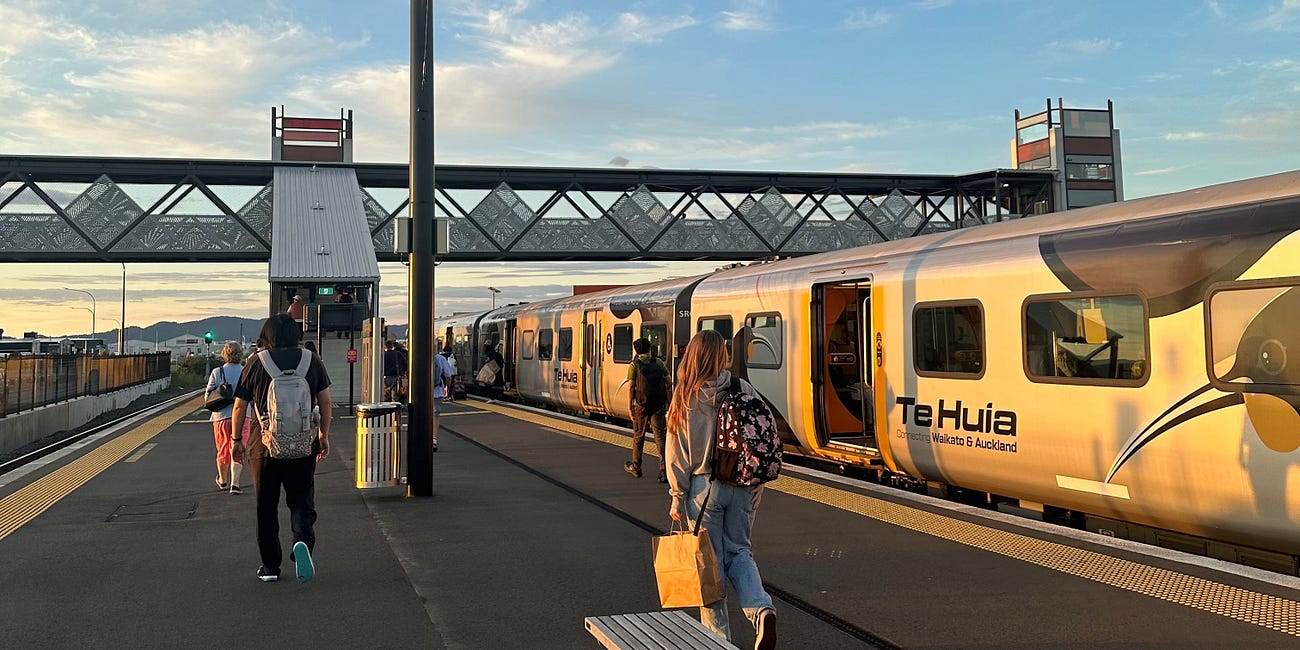The latest ups and downs of Te Huia
Te Huia, the regional train between Hamilton and Auckland, has had its fair share of ups and down. So read on for the latest on Te Huia.
Transport discourse in Aotearoa
There’s something strange about transport discourse in Aotearoa/ New Zealand as elsewhere. Public transport is often considered a subsidy while roads are considered an investment. The investment of $98 million into capex and five years operating subsidy for Te Huia has been treated by some as a boondoggle while the investment of $2.1 billion in the parallel Waikato Expressway has barely raised an eyebrow. And don’t get me started on the Roads of National Significance programme, for which there appears to be no plausible funding pathway that doesn’t either involve manna from heaven or printing money. This distorted discourse helps explain the extraordinarily intense questioning which Te Huia has been subject to.

The state of Te Huia
Te Huia launched in April 2021 with two weekday return services between Hamilton, Rotokauri, Huntly and Papakura - and one return service on a Saturday.
Over the past four years, various improvements to Te Huia have been made including:
Extension of the service to The Strand in central Auckland.
Additional station stop at Puhinui (with onward connections to Auckland Airport).
Additional daily return service on Thursdays, Fridays and Saturdays from February 2024.
Additional stop at the upgraded Pukekohe station from February 2025, resulting in faster overall trip time of up to 15 minutes.
Te Huia has steadily gained patronage in line with these progressive improvements and passenger satisfaction remains extremely high. But it has had its share of challenges and for readers unfamiliar with the background, I suggest reading this piece from 2024.
In this piece, I will cover developments in the past year, focusing on what happened, if anything to my six ideas to improve Te Huia from mid-2024.
1. More station stops in North Waikato
Te Huia passes but does not stop at three areas experiencing significant growth in the upper North Waikato, Te Kauwhata, Pōkeno, Tūākau as well as Pukekohe in Auckland. Some good news here as Pukekohe became a station stop for Te Huia on 10 February 2025, a week after the reopening of the station upon the completion of Papakura to Pukekohe rail electrification. In addition, the route 44 bus from Pōkeno to Pukekohe via Tūākau was retimed to meet Te Huia departure and arrival times. This gives two of the three upper North Waikato communities on the rail line access via feeder bus to Te Huia at Pukekohe Station.

As for permanent upper North Waikato stations, Waikato District Council completed an indicative business case for railway stations in the northern Waikato in August 2023 focussed on Tūākau, Pōkeno and Te Kauwhata.
The next step is to progress a detailed business case for which there is currently no funding which will need to be considered through the 2025-2034 Long Term Plan process. There is no guarantee that funding for a Detailed Business Case will be allocated in the current fiscally constrained environment1.
2. More frequency
Some good news on this front. At their meeting on 16 May 2025, the Waikato Regional Council Future Proof Public Transport Sub Committee recommended Waikato Regional Council approve reallocation of reserve funding to enable the launch of a Te Huia Sunday return service, a recommendation that the full council subsequently endorsed at its meeting on 29 May 2025. The service has support from the KiwiRail (as the network provider) Auckland Timetable Committee at its meeting on 3 April 2025. The service will leave Kirikiriroa/ Hamilton at 2:45pm on Sundays and return from Tāmaki Makaurau/ Auckland at 6.15pmpm. This service enables both Hamilton and Auckland residents to spend the weekend in the other city and get back home on Sunday afternoon or evening. It launches on Sunday 27 July 2025.
On less good news, lengthy Auckland rail shutdowns in preparation for the opening of City Rail Link in 2026 has led to consequential lengthy shutdowns for Te Huia.

A self-evident element of public transport is that it’s only useful when it actually operates. And people’s need for the service doesn’t simply magically switch off over school holidays and public holiday long weekends. Te Huia is the only train service in Aotearoa/ New Zealand that isn’t replaced by buses when it’s not operating. In my view, providing a replacement when you can’t operate a service is pretty much the bare minimum to expect. Sadly though in New Zealand, coach buses likely to be used as longer distance train replacements aren’t required to provide for people with disabilities, don’t generally have toilets and have steep steps that are difficult for anyone with any sort of mobility challenge.
Hopefully this issue will self-resolve in 2026 once Auckland’s City Rail Link is open but that is still around a year away and literally leaves many potential customers in the lurch in the meantime.
3. Better bus connections at both ends
As noted above, Waikato’s route 44 bus now provides a timed connection from Pōkeno and Tūākau to and from Te Huia at Pukekohe Station. But there’s no updates on the other suggested improvements in my previous piece.
4. A station stop in Pukekohe
This has since happened as noted above and in addition to providing Waikato folks access to Pukekohe, it provides Pukekohe folks access to the Waikato.
5. Auckland paying its fair share
It seems that the Waikato’s lobbying efforts with Auckland to contribute to Te Huia in line with the benefits it receives (as 22% of Te Huia’s customers are from Auckland) have fallen on deaf ears. It saddens me that my home town of Auckland seems to feel that it is apart from New Zealand, not a part of New Zealand.
6. The need for more speed
Some good news here but also a dark cloud on the horizon. The completion of the Rail Network Rebuild in Auckland, along with better timetabling, has led to some improvements in Te Huia’s travel time, especially in the 18 kilometre stretch between Pukekohe and Papakura. This has enabled average trip speed to increase a bit from 52km/h to 55km/h.
But difficulties in finding a feasible solution to implement European Train Control System (ETCS) level 1 in the cabs of the DFB locomotives that operate Te Huia means that, if not resolved, Te Huia could be limited to a maximum speed of 80 km/h, as opposed to the current 100 km/h. While average speed is more important that top speed, significant sections of track between Hamilton and Te Kauwhata allow for 100 km/h running except for some curves, especially in the Taupiri Gorge and across the Ngāruawāhia rail bridge. At present, the 24 minute Te Huia travel time between Rotokauri and Rahui-Pōkeka/ Huntly is competitive with car travel for the same journey. For the 48 kilometre stretch from Rotokauri to Te Kauwhata, which is largely 100 km/h running, a reduction to a top speed of 80 km/h could add around 6 minutes in travel time. This would more than cancel out the benefits of improved speeds within the Auckland electrified network.
More detail on this challenge is available in Michael van Drogenbroek’s excellent LinkedIn post on the subject (and from where I sourced some of the information above).
Final thoughts
There have been some useful improvements in Te Huia in the past year with more in the offing. But also some further headwinds, particularly with the fitment for ETCS in the locomotives. This fitment would avoid the risk of SPADs (Signal Passed at Danger) as occurred with Te Huia at Penrose in June 2023 and is essential for the safe operation of higher frequency rail services in Auckland once City Rail Links opens.
To give you a sense of the huger efforts happening behind the scenes in the Waikato to make Te Huia a permanent service at the conclusion of its trial, I append this extract from the February 2025 Waikato Passenger Transport Committee agenda. My italics.
Te Huia Developments
The Te Huia rail service is undergoing a programme of work to support the continuation of the service beyond the end of the trial period in April 2026. This requires investment in a number of business cases and confirmation of future finances to ensure the ongoing delivery of this service.
To support this investment will require undertaking a business case, or collection of business cases, to support the development and scoping of the future service. This will intially require submitting a Point of Entry to NZTA [New Zealand Transport Agency] for assessment. Following this, specific business cases will look at projects for the programme, including: An update of Rolling Stock Business Case, a business case for Carriage Configurations, a business case for North Waikato Railway Stations as well as a business case for Forecast of Future demand.
It is also necessary to understand financing for long term operating costs, including what contribution from the NZTA Continuous Programme for Public Transport is available, and investigating inter-regional financial contributions requiring engagement with Auckland Council.
Additionally, an End of Trial Review will be required to submit to the NZTA Board for consideration this will include an assessment of benefits realisation for the service, Key Performance Indicator analysis and a measures review. This work is being initiated now and it is expected that a paper for the information of the committee will be available at the August meeting.
All of this work supports designing the service for beyond 2026 with a view to the implementation of the permanent service for 2026 and beyond.
Future Proof Public Transport Subcommittee Agenda, 21 February 2025, page 32
On top of this, Te Huia will need new trains when it becomes a permanent service. The existing Te Huia carriages are ex-British Rail and date from the 1970s. They have performed very well but will need to retire by the end of this decade.
Waikato Regional Council is working on a business case for investment in new trains which could be a combination of electric and battery, and this will be submitted to the government. If successful, the Waikato will need to place an order in either 2025 or 2026.
All of this should give you a sense of how much effort the Waikato is continuing to put into Te Huia and a sense of the sheer amount of work required to get an inter-regional rail service up, running and continuing in Aotearoa.
All-in-all Te Huia keeps on keeping on with strong political and staff support in the Waikato (and absolutely none in Auckland to its shame). But do please provide replacement bus services when Te Huia is not able to operate. Public transport needs reliable service, not part-time service that can be turned on and off. Kia kaha Te Huia.
Information sourced from Te Huia: Future Plans





A Ngāruawāhia stop would hook into the Te Awa River Ride nicely for cyclists, even if just Friday/weekends
For the replacement trains when the BR MK II cars reach end of life (yes they've had extensicve panelbeating but at core they are more than 50 years old already), why not hook into the supply chain for the new hybrid trains proposed for the Wellington region? The wheel doesn't need reinventing a thousand times.